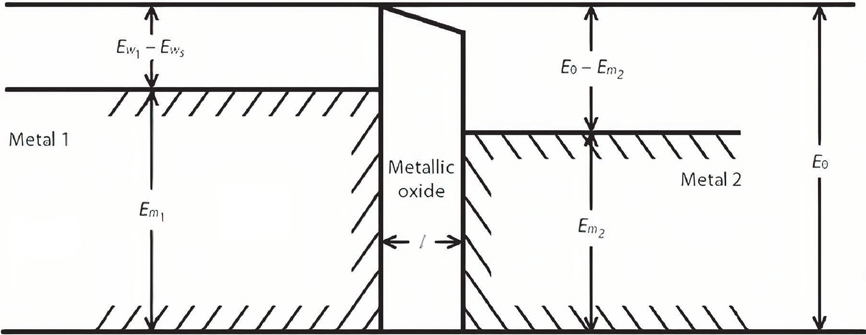Faraz Kaiser Malik, Kristel Fobelets. A review of thermal rectification in solid-state devices[J]. Journal of Semiconductors, 2022, 43(10): 103101
Search by keywords or author
- Journal of Semiconductors
- Vol. 43, Issue 10, 103101 (2022)
![Energy band diagram of an interface between dissimilar metals separated by a dielectric.Ews is the work function of the oxide layer, whileEwi andEmi represent the work function and Fermi level respectively of metali. Reprinted from Moon and Keeler[28], Copyright 1962, with permission from Elsevier.](/richHtml/jos/2022/43/10/103101/103101-1.jpg)
Fig. 1. Energy band diagram of an interface between dissimilar metals separated by a dielectric.
28 ], Copyright 1962, with permission from Elsevier.
![(Color online) Illustration of a thermal rectification system constituted of two materials with differing temperature dependence of thermal conductivity,κ under (a) forward and (b) reverse thermal bias. Reprinted with permission from Aroraet al.[42], Copyright 2017 by the American Physical Society.](/richHtml/jos/2022/43/10/103101/103101-2.jpg)
Fig. 2. (Color online) Illustration of a thermal rectification system constituted of two materials with differing temperature dependence of thermal conductivity,
42 ], Copyright 2017 by the American Physical Society.
Fig. 3. (a) Illustration of the thickness-asymmetric graphene nanoribbon and (b) variation of the thermal conductivity of the specimen with temperature and grain orientation under forward and reverse thermal bias. Reprinted from Zhonget al.[56 ], with the permission of AIP Publishing.
Fig. 4. (Color online) Illustration of a thermally rectifying pillared graphene–monolayer graphene structure. Reprinted with permission from Yousefiet al.[57 ], © IOP Publishing.
Fig. 5. (Color online) (a) Illustration of the asymmetric tilt grain boundary and (b) the resulting inequality in thermal conductivity of the specimen under opposing thermal bias. Reprinted from Caoet al.[58 ], Copyright 2012, with permission from Elsevier.
Fig. 6. (Color online) (a) Illustration of the asymmetric graphene/h-BN heterostructures and (b) variation of the thermal rectification efficiency with the asymmetricity parameter. Note that
13 ], Copyright 2017, with permission from Elsevier.
Fig. 7. (Color online) (a) Illustration of the graphene/h-BN heterostructure, and the variation of the thermal rectification efficiency and (b) forward and reverse heat flux with the inter-layer coupling strength
51 ]. Copyright 2020 American Chemical Society.
Fig. 8. Illustration of the (a) monolayer graphene nanoribbon/silicon and (b) vertical carbon nanotube/silicon heterostructures. Reprinted from Vallabhaneniet al.[61 ], with the permission of AIP Publishing.
Fig. 9. (Color online) (a) Schematic illustration of the triangular and rectangular graphene nanoribbon geometries. (b) A comparison of the heat flux under forward and reverse thermal biasΔ with
69 ], with the permission of AIP Publishing.
Fig. 10. (Color online) (a) Asymmetric geometrical MoS2 ribbon shapes. (b) Variation of temperature along the length of symmetric and trapezoidal nanoribbons with circles and squares representing forward and reverse thermal bias respectively. (c) Variation of the thermal rectification efficiency with geometrical asymmetricity for the three different ribbon shapes. (d) A comparison of the phonon participation ratios under opposing thermal biases for T-shaped ribbons with
72 ], with permission from the Royal Society of Chemistry.
Fig. 11. (Color online) (a) Thermal analysis of the three different geometrically asymmetric MoS2 nanoribbons in the forward bias direction and (b) comparison of the experimentally determined thermal rectification efficiency of the three structures calculated as
Table 1 . Adapted with permission from Yanget al.[73 ], Copyright 2020 American Chemical Society.
Fig. 12. (Color online) Illustration of the asymmetrically defective single-walled carbon nanotube, and the one-dimensional model used to simulate the system. Reprinted by permission from Springer Nature: Springer Journal of Mechanical Science and Technology, Hayashiet al.[76 ], Copyright 2011.
Fig. 13. (Color online) A comparison of the thermal conductivity spectra for pristine graphene and 500 nm-long defective graphene. Reprinted with permission from Aroraet al.[42 ], Copyright 2017 by the American Physical Society.
Fig. 14. (Color online) An illustration of the origin of thermal rectification in asymmetrically defective structures in terms of spatial asymmetry in the thermal conductivity
19 ].
Fig. 15. (Color online) Influence of thermal bias on the overlap in the phonon density of states
78 ], Copyright 2018, with permission from Elsevier.
Fig. 16. (Color online) Influence of vacancy pattern modifications on the thermal rectification in micrometre-length silicon at room temperature. ‘Hierarchical’ indicates the presence of smaller pores between the larger ones, while ‘compressed’ refers to reduced interpore distances. Reprinted from Chakrabortyet al.[11 ], with the permission of AIP Publishing.
Fig. 17. (Color online) Illustration of the experimentally determined thermal rectification in a porous silicon membrane. Adapted from Kasprzaket al.[82 ].
|
Table 1. Comparison of the maximum thermal rectification efficiency reported according to Eq. (1) in previous literature using different rectification mechanisms.

Set citation alerts for the article
Please enter your email address



